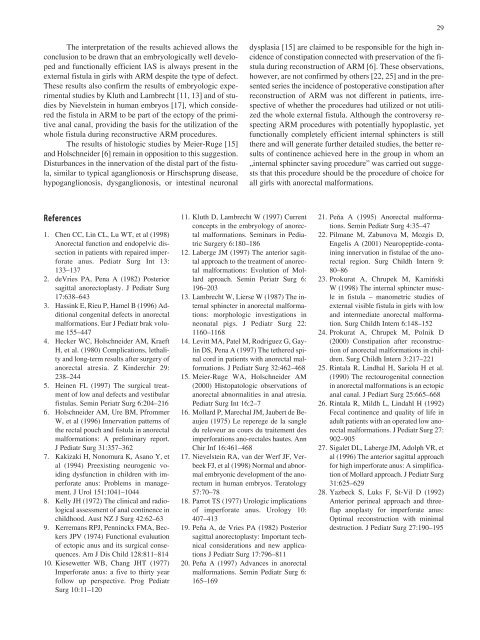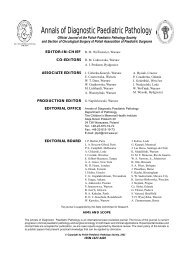annals 1-2.qxd - Centrum Zdrowia Dziecka
annals 1-2.qxd - Centrum Zdrowia Dziecka
annals 1-2.qxd - Centrum Zdrowia Dziecka
Create successful ePaper yourself
Turn your PDF publications into a flip-book with our unique Google optimized e-Paper software.
29<br />
The interpretation of the results achieved allows the<br />
conclusion to be drawn that an embryologically well developed<br />
and functionally efficient IAS is always present in the<br />
external fistula in girls with ARM despite the type of defect.<br />
These results also confirm the results of embryologic experimental<br />
studies by Kluth and Lambrecht [11, 13] and of studies<br />
by Nievelstein in human embryos [17], which considered<br />
the fistula in ARM to be part of the ectopy of the primitive<br />
anal canal, providing the basis for the utilization of the<br />
whole fistula during reconstructive ARM procedures.<br />
The results of histologic studies by Meier-Ruge [15]<br />
and Holschneider [6] remain in opposition to this suggestion.<br />
Disturbances in the innervation of the distal part of the fistula,<br />
similar to typical aganglionosis or Hirschsprung disease,<br />
hypoganglionosis, dysganglionosis, or intestinal neuronal<br />
dysplasia [15] are claimed to be responsible for the high incidence<br />
of constipation connected with preservation of the fistula<br />
during reconstruction of ARM [6]. These observations,<br />
however, are not confirmed by others [22, 25] and in the presented<br />
series the incidence of postoperative constipation after<br />
reconstruction of ARM was not different in patients, irrespective<br />
of whether the procedures had utilized or not utilized<br />
the whole external fistula. Although the controversy respecting<br />
ARM procedures with potentially hypoplastic, yet<br />
functionally completely efficient internal sphincters is still<br />
there and will generate further detailed studies, the better results<br />
of continence achieved here in the group in whom an<br />
„internal sphincter saving procedure” was carried out suggests<br />
that this procedure should be the procedure of choice for<br />
all girls with anorectal malformations.<br />
References<br />
1. Chen CC, Lin CL, Lu WT, et al (1998)<br />
Anorectal function and endopelvic dissection<br />
in patients with repaired imperforate<br />
anus. Pediatr Surg Int 13:<br />
133–137<br />
2. deVries PA, Pena A (1982) Posterior<br />
sagittal anorectoplasty. J Pediatr Surg<br />
17:638–643<br />
3. Hassink E, Rieu P, Hamel B (1996) Additional<br />
congenital defects in anorectal<br />
malformations. Eur J Pediatr brak volume<br />
155–447<br />
4. Hecker WC, Holschneider AM, Kraeft<br />
H, et al. (1980) Complications, lethality<br />
and long-term results after surgery of<br />
anorectal atresia. Z Kinderchir 29:<br />
238–244<br />
5. Heinen FL (1997) The surgical treatment<br />
of low anal defects and vestibular<br />
fistulas. Semin Periatr Surg 6:204–216<br />
6. Holschneider AM, Ure BM, Pfrommer<br />
W, et al (1996) Innervation patterns of<br />
the rectal pouch and fistula in anorectal<br />
malformations: A preliminary report.<br />
J Pediatr Surg 31:357–362<br />
7. Kakizaki H, Nonomura K, Asano Y, et<br />
al (1994) Preexisting neurogenic voiding<br />
dysfunction in children with imperforate<br />
anus: Problems in management.<br />
J Urol 151:1041–1044<br />
8. Kelly JH (1972) The clinical and radiological<br />
assessment of anal continence in<br />
childhood. Aust NZ J Surg 42:62–63<br />
9. Kerremans RPJ, Penninckx FMA, Beckers<br />
JPV (1974) Functional evaluation<br />
of ectopic anus and its surgical consequences.<br />
Am J Dis Child 128:811–814<br />
10. Kiesewetter WB, Chang JHT (1977)<br />
Imperforate anus: a five to thirty year<br />
follow up perspective. Prog Pediatr<br />
Surg 10:11–120<br />
11. Kluth D, Lambrecht W (1997) Current<br />
concepts in the embryology of anorectal<br />
malformations. Seminars in Pediatric<br />
Surgery 6:180–186<br />
12. Laberge JM (1997) The anterior sagittal<br />
approach to the treatment of anorectal<br />
malformations: Evolution of Mollard<br />
aproach. Semin Periatr Surg 6:<br />
196–203<br />
13. Lambrecht W, Lierse W (1987) The internal<br />
sphincter in anorectal malformations:<br />
morphologic investigations in<br />
neonatal pigs. J Pediatr Surg 22:<br />
1160–1168<br />
14. Levitt MA, Patel M, Rodriguez G, Gaylin<br />
DS, Pena A (1997) The tethered spinal<br />
cord in patients with anorectal malformations.<br />
J Pediatr Surg 32:462–468<br />
15. Meier-Ruge WA, Holschneider AM<br />
(2000) Histopatologic observations of<br />
anorectal abnormalities in anal atresia.<br />
Pediatr Surg Int 16:2–7<br />
16. Mollard P, Marechal JM, Jaubert de Beaujeu<br />
(1975) Le reperege de la sangle<br />
du releveur au cours du traitement des<br />
imperforations ano-rectales hautes. Ann<br />
Chir Inf 16:461–468<br />
17. Nievelstein RA, van der Werf JF, Verbeek<br />
FJ, et al (1998) Normal and abnormal<br />
embryonic development of the anorectum<br />
in human embryos. Teratology<br />
57:70–78<br />
18. Parrot TS (1977) Urologic implications<br />
of imperforate anus. Urology 10:<br />
407–413<br />
19. Peňa A, de Vries PA (1982) Posterior<br />
sagittal anorectoplasty: Important technical<br />
considerations and new applications<br />
J Pediatr Surg 17:796–811<br />
20. Peňa A (1997) Advances in anorectal<br />
malformations. Semin Pediatr Surg 6:<br />
165–169<br />
21. Peňa A (1995) Anorectal malformations.<br />
Semin Pediatr Surg 4:35–47<br />
22. Pilmane M, Zabunova M, Mozgis D,<br />
Engelis A (2001) Neuropeptide-containing<br />
innervation in fistulae of the anorectal<br />
region. Surg Childh Intern 9:<br />
80–86<br />
23. Prokurat A, Chrupek M, Kamiñski<br />
W (1998) The internal sphincter muscle<br />
in fistula – manometric studies of<br />
external visible fistula in girls with low<br />
and intermediate anorectal malformation.<br />
Surg Childh Intern 6:148–152<br />
24. Prokurat A, Chrupek M, Polnik D<br />
(2000) Constipation after reconstruction<br />
of anorectal malformations in children.<br />
Surg Childh Intern 3:217–221<br />
25. Rintala R, Lindhal H, Sariola H et al.<br />
(1990) The rectourogenital connection<br />
in anorectal malformations is an ectopic<br />
anal canal. J Pediart Surg 25:665–668<br />
26. Rintala R, Mildh L, Lindahl H (1992)<br />
Fecal continence and quality of life in<br />
adult patients with an operated low anorectal<br />
malformations. J Pediatr Surg 27:<br />
902–905<br />
27. Sigalet DL, Laberge JM, Adolph VR, et<br />
al (1996) The anterior sagittal approach<br />
for high imperforate anus: A simplification<br />
of Mollard approach. J Pediatr Surg<br />
31:625–629<br />
28. Yazbeck S, Luks F, St-Vil D (1992)<br />
Anterior perineal approach and threeflap<br />
anoplasty for imperforate anus:<br />
Optimal reconstruction with minimal<br />
destruction. J Pediatr Surg 27:190–195

















